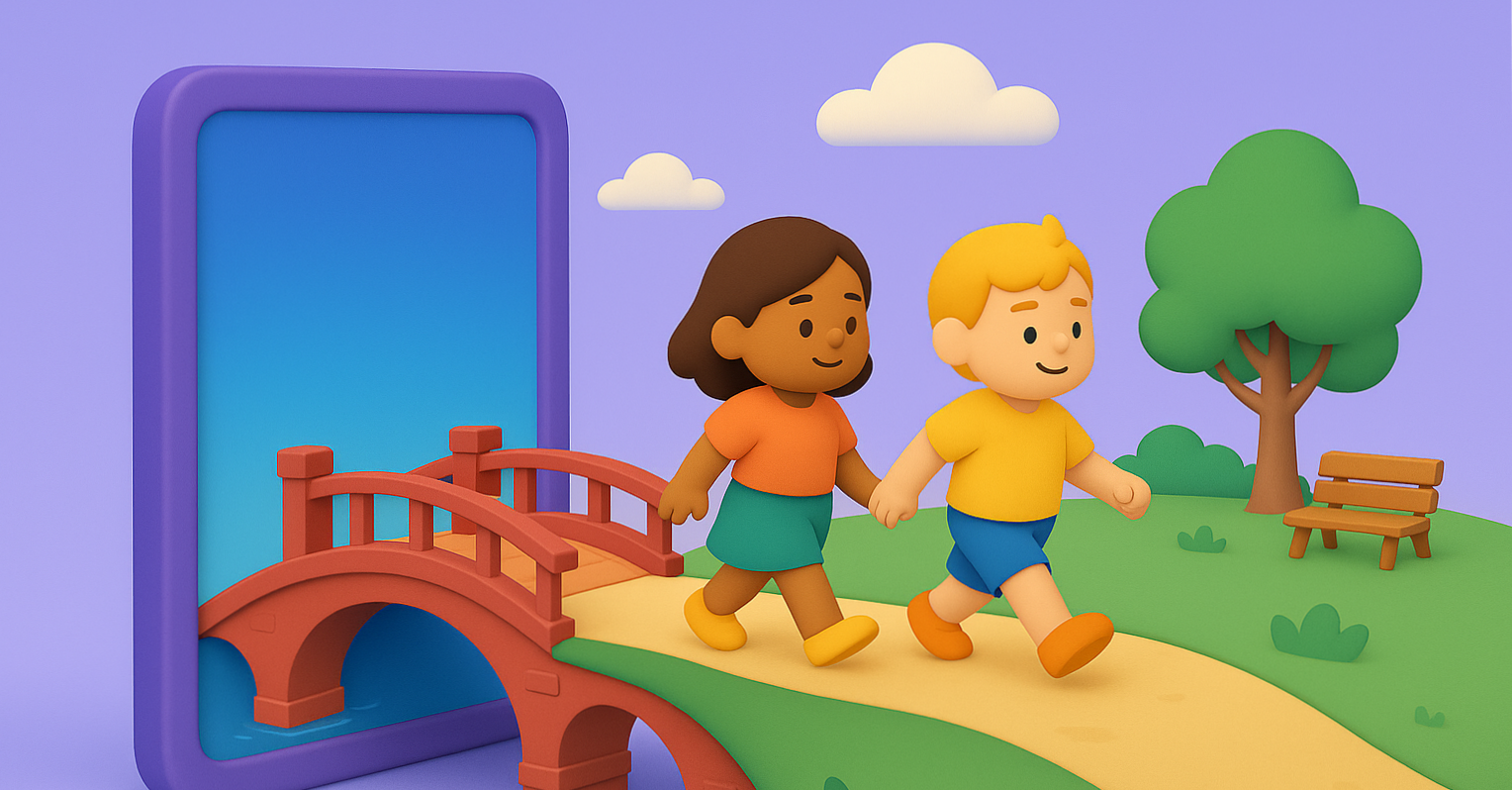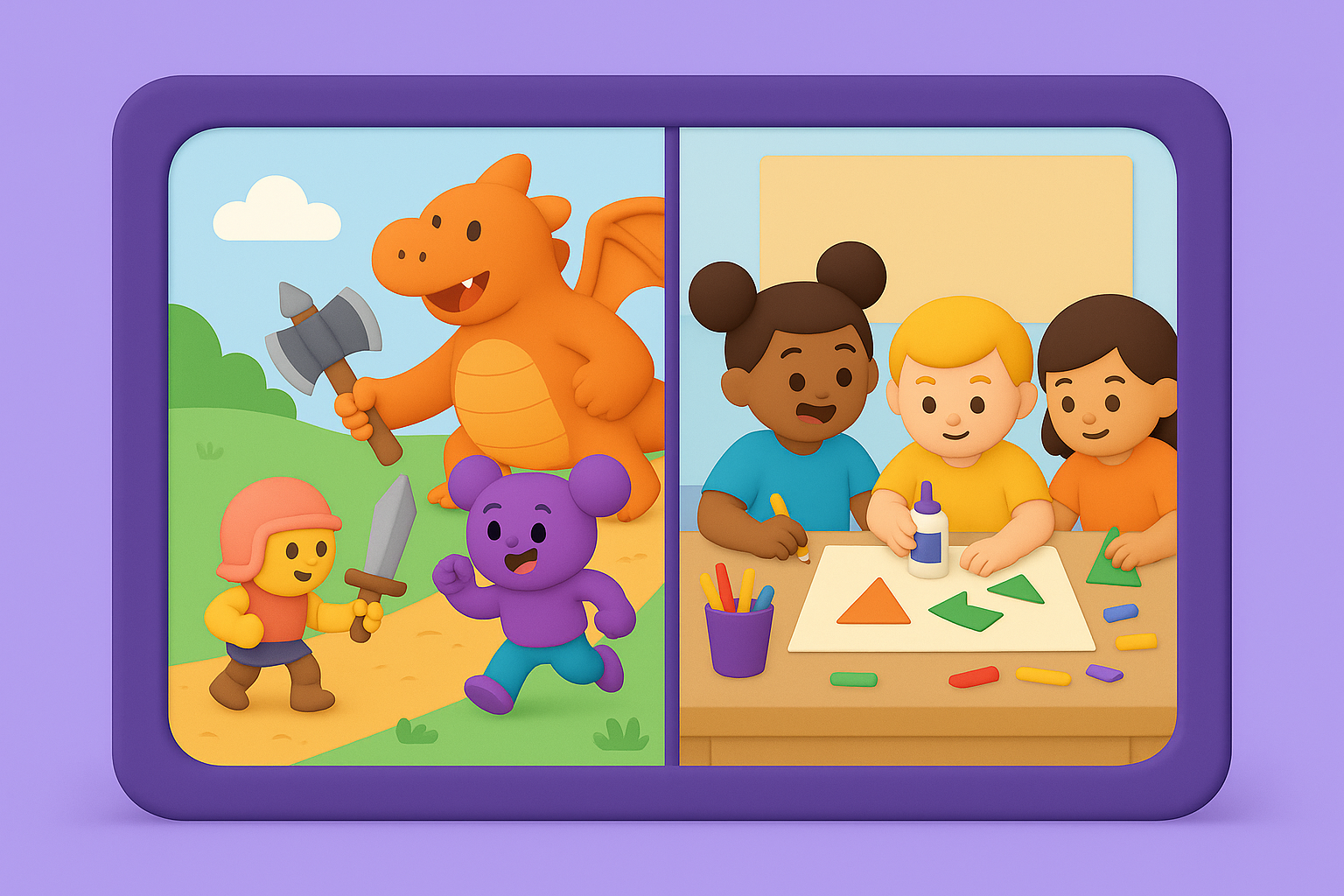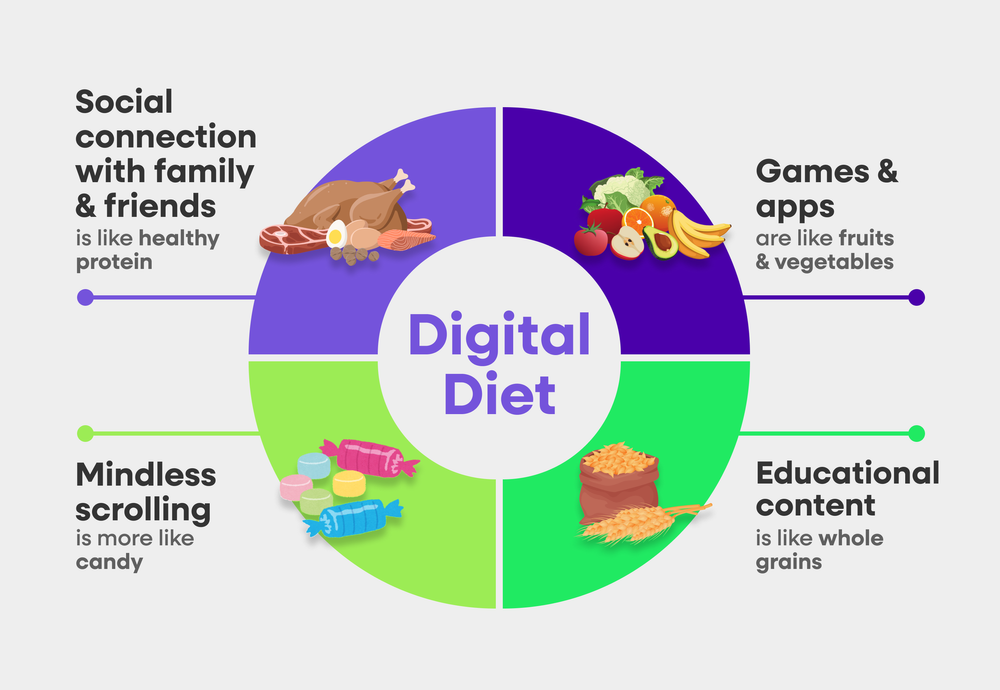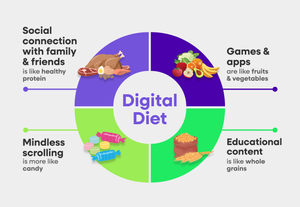Screens are often seen as “less than.” A less valuable use of our time. Facilitating less valuable relationships. Even less valuable learning. For whatever reason, screen-based activities are often treated as both separate from and “less than” everything else. If it happens on a screen, it is somehow less “real life.”
But for kids in our digital era, this division doesn’t exist. To them, online and offline aren’t opposing worlds. They’re extensions of the same life.
Really, I think if we’re honest with ourselves, most adults can admit the same is true for us. How many of us spend 8+ hours a day working remotely in “another world?” Would you say the time we spend there is notably different or distinct from “real life”? Of course not, because it is simply life (#worklife).
When we treat digital experiences as disconnected or inferior, we risk missing what is actually happening right in front of us. It’s overlooking how what we do, say, and see through our devices show up outside in our lives when we aren’t plugged in.
A screen-based place is just another environment where life happens — and where learning, development, growth, and relationships happen.
What if, instead of viewing screen time as a barrier, we recognized it for what it often is: a bridge?
Why “Online vs. Offline” is the Wrong Question
“Online or offline is a false dichotomy” is something I have said nearly ad nauseam for the last decade.
Why do I keep repeating myself? Because it is incorrect to think of the digital world as not part of the “real” world. To do so will hinder our ability to understand how screen-based activities are powerful opportunities for growth, connection, and learning (and even making a living! Case in point: I have been working remotely for the last decade).

Perhaps there was a time when screens did show us a much less “real” world, if you’ve got black-and-white sitcoms in mind, but are we forgetting… the news?
Just because it’s broadcast to our TV screens, is the news not showing us the real world (opinions of media bias notwithstanding)?
If the enduring parental advice is to limit screen time, restrict it entirely, or apologize and feel guilty for it, it’s no wonder we’ve come to think of it as a separate world.
We’ve inherited a cultural script that says real learning happens offline. That screen time is something to restrict, limit, or apologize for.
Our kids are digital natives. They are born into a world where screens are everywhere, often seamlessly integrated with their off-screen activities. They don’t split their lives into “real” and “digital.” When something funny happens in a game, they want to tell their friends at school. When a challenge in a game frustrates them, they feel it the same way they’d feel a playground disagreement.
The impact of what we do, see, and experience on a screen is not somehow magically confined to the virtual walls of those screens.
Research supports this idea, too. Just as online bullying can have real-world consequences, learning that happens on screens doesn’t stay confined to the screen. It’s absorbed. Applied. Rehearsed. Brought into the physical world in ways both obvious and subtle.
Can we stop asking, “How do we separate screen time from real life?” and start asking, “How do we support what’s happening across both?” This shift in thinking can get us a lot closer to what kids actually need from our digital parenting and the rest of the world.
What the Research Shows About Digital Learning
There’s a growing body of evidence that digital games can support the development of essential cognitive, emotional, and social skills. That’s especially true when those games are designed with intention and used in supportive environments.
Games are, at their core, problem-solving systems. Players learn by trying, failing, adjusting, and trying again. This structure — called scaffolding — mirrors how we learn in traditional settings, building knowledge step-by-step with increasing complexity.
Motivation within these games is often driven by what’s known as Self-Determination Theory: the idea that people learn best when they feel free to make their own choices, are successful at navigating challenges, and are connected to others. When digital tools are built to support those needs, learning deepens.
There is a wealth of research to support this. Researchers have found that when educational games align with children’s psychological needs, they foster deeper engagement and more successful skill transfer beyond the screen. Game-based learning can also boost motivation, engagement, and the development of new skills and abilities, including, but not limited to, attention control, spatial reasoning, and visual processing.
Notably, the results were even more pronounced when those games were paired with scaffolding and caregiver support. Digital games are really effective motivational tools, experiential learning spaces, and powerful vehicles for developing emotional and cognitive capacities.
One of the pioneering scholars in this space, James Paul Gee, actually identified more than thirty learning principles embedded in good video game design. These principles mirror effective teaching:
- Active learning
- Systems thinking
- The power of meaningful failure
I could go on citing studies conducted over the past 20+ years, but I think the point is clear. Learning doesn’t have to happen at a desk to count. In fact, any kind of active learning is likely a better way to learn than a desk, a board, and a lecture. Given all the worlds, experiences, and lessons we can model in a digital world, it’s no wonder screen-based learning can be so effective. It’s not about replacing off-screen experiences, but reinforcing them.
With the right scaffolding and support, screen time can offer meaningful opportunities for growth. It can bridge the gap between what kids practice in games and how they behave when they are unplugged — and not just in academics, but for life skills, too.
Kids Naturally Carry Lessons Between Worlds
The idea that kids compartmentalize any part of their lives is a funny thought. Children are meaning-makers. They don’t need a formal lesson plan to absorb new thoughts or ideas. They find patterns, stories, feedback, and emotional cues in everything, including their digital activities.
A child who leads a team to victory in a co-op game may be practicing the same core skills they’ll use during group projects in school:
- Communication
- Delegation
- Resilience
- Strategy
- Patience
Whether or not they’re aware of it in the moment, those experiences shape how they interact with others in the off-screen world.

Unintentional learning is just as powerful. Kids observe cause and effect, read social dynamics, and experiment with decision-making, whether they’re building a pixelated house or solving a logic puzzle.
Co-Engagement Is the Bridge Builder
So, how can we make these digital learning and life skill bridges even stronger?
One of the most potent ways to support learning across digital and physical spaces is co-engagement. That doesn’t always mean sitting side-by-side playing every game together, but it does mean staying connected to what your child is doing. Ask questions. Show interest. Reflect together.
For example, after logging off for dinner, you could ask your child:
- What did you play today?
- Who did you play with?
- Why do you like that game?
If you are watching them play, you could ask some prompting questions like:
- Why are you choosing that path?
- Can you tell me something about the character that you are playing?
If you are looking for some general conversation starters around games, you could ask something like:
- What is your favorite game to play and why?
- Do you think I would like that game? Why or why not?
It may seem like a small thing, but these moments of shared conversation can help kids make sense of their experiences and begin to generalize what they’ve learned.
And remember, it is not just the content of what they are doing on their screens that matters, but the context. These Three Cs — Content, Context, and Communication — are threads of digital parenting I bring up a lot throughout The Parent's Guide to Screen Time for Kids.
High-quality digital media can support learning, especially when parents co-view, co-play, and engage in conversation. Plus, co-engagement eases the anxiety many parents feel about screen time. When you’re part of it, you don’t have to wonder what your child is doing, because you know. You’ve seen the choices they’re making, the challenges they’re tackling, and the curiosity they’re bringing to the experience. You know the game is enriching and age-appropriate because you’re experiencing it with them.
Screens are Stepping Stones, Not Silos
As long as we keep the concept of a digital diet in mind and remain intentional about how we use screens as a digital parenting tool, screens aren’t a threat or just a treat.

When we turn to screens with a clear purpose — even if that purpose is getting dinner on the table — and align them with our kids’ developmental stage, our family’s values, and our parenting styles, they become a space for connection, not just consumption.
If we want to support children in developing essential life skills — such as communication, critical thinking, resilience, and practical skills like financial literacy — we need to meet them where they are. That means recognizing that digital spaces are part of their world. Not something to be siloed off or feared, but something to be explored and guided, just like any other part of their lives.
When used thoughtfully, it’s not just entertainment. Digital play becomes a way to develop critical life skills. It becomes a bridge from what they’re playing to who they’re becoming.






 Copy Link
Copy Link
 Share
to X
Share
to X
 Share
to Facebook
Share
to Facebook
 Share
to LinkedIn
Share
to LinkedIn
 Share
on Email
Share
on Email




